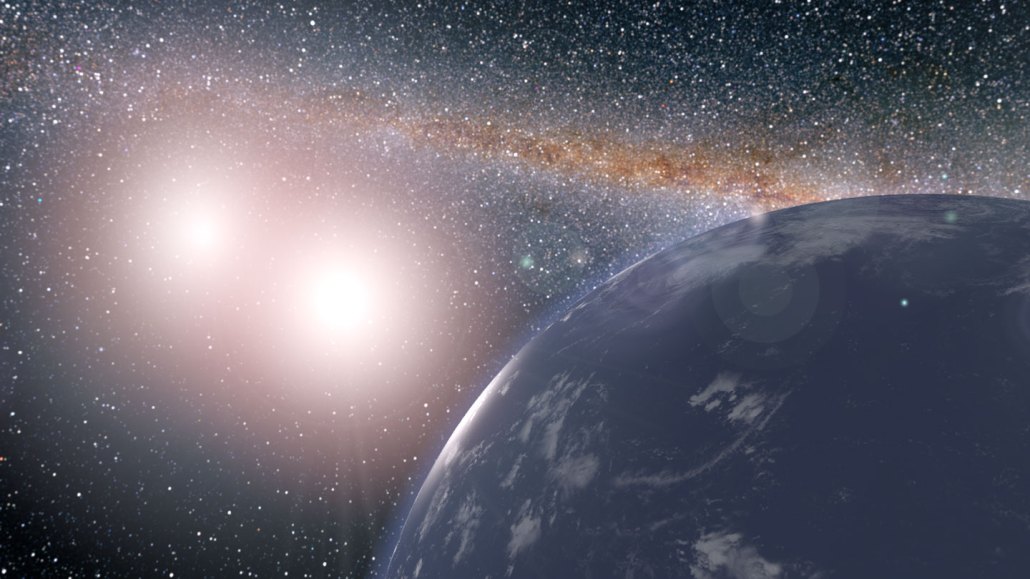
Planets with twin suns, such as this hypothetical world in the Kepler-35 system (shown in an artist's impression), may make up the bulk of habitable worlds in the universe.
JPL-Caltech/NASA
- More than 2 years ago
Read another version of this article at Science News Explores
SEATTLE — Luke Skywalker’s home planet in Star Wars is the stuff of science fiction. But Tatooine-like planets in orbit around pairs of stars might be our best bet in the search for habitable planets beyond our solar system.
Many stars in the universe come in pairs. And lots of those should have planets orbiting them (SN: 10/25/21). That means there could be many more planets orbiting around binaries than around solitary stars like ours. But until now, no one had a clear idea about whether those planets’ environments could be conducive to life. New computer simulations suggest that, in many cases, life could imitate art.
Earthlike planets orbiting some configurations of binary stars can stay in stable orbits for at least a billion years, researchers reported January 11 at the American Astronomical Society meeting. That sort of stability, the researchers propose, would be enough to potentially allow life to develop, provided the planets aren’t too hot or cold.
Of the planets that stuck around, about 15 percent stayed in their habitable zone — a temperate region around their stars where water could stay liquid — most or even all of the time.
The researchers ran simulations of 4,000 configurations of binary stars, each with an Earthlike planet in orbit around them. The team varied things like the relative masses of the stars, the sizes and shapes of the stars’ orbits around each other, and the size of the planet’s orbit around the binary pair.
The scientists then tracked the motion of the planets for up to a billion years of simulated time to see if the planets would stay in orbit over the sorts of timescales that might allow life to emerge.
A planet orbiting binary stars can get kicked out of the star system due to complicated interactions between the planet and stars. In the new study, the researchers found that, for planets with large orbits around star pairs, only about 1 out of 8 were kicked out of the system. The rest were stable enough to continue to orbit for the full billion years. About 1 in 10 settled in their habitable zones and stayed there.
Of the 4,000 planets that the team simulated, roughly 500 maintained stable orbits that kept them in their habitable zones at least 80 percent of the time.
“The habitable zone . . . as I’ve characterized it so far, spans from freezing to boiling,” said Michael Pedowitz, an undergraduate student at the College of New Jersey in Ewing who presented the research. Their definition is overly strict, he said, because they chose to model Earthlike planets without atmospheres or oceans. That’s simpler to simulate, but it also allows temperatures to fluctuate wildly on a planet as it orbits.
“An atmosphere and oceans would smooth over temperature variations fairly well,” says study coauthor Mariah MacDonald, an astrobiologist also at the College of New Jersey. An abundance of air and water would potentially allow a planet to maintain habitable conditions, even if it spent more of its time outside of the nominal habitable zone around a binary star system.
The number of potentially habitable planets “will increase once we add atmospheres,” MacDonald says, “but I can’t yet say by how much.”
She and Pedowitz hope to build more sophisticated models in the coming months, as well as extend their simulations beyond a billion years and include changes in the stars that can affect conditions in a solar system as it ages.
The possibility of stable and habitable planets in binary star systems is a timely issue says Penn State astrophysicist Jason Wright, who was not involved in the study.
“At the time Star Wars came out,” he says, “we didn’t know of any planets outside the solar system, and wouldn’t for 15 years. Now we know that there are many and that they orbit these binary stars.”
These simulations of planets orbiting binaries could serve as a guide for future experiments, Wright says. “This is an under-explored population of planets. There’s no reason we can’t go after them, and studies like this are presumably showing us that it’s worthwhile to try.”







